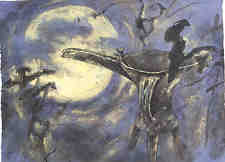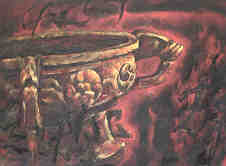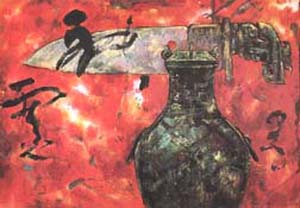|
Return to the
Topics
selection Page
And in the world at this time...
For review:
Can you identify the shapes of the bronze vessels portrayed in the paintings on this page or in the
Bronze Age Series
This web site is
under construction. Please send comments or suggestions to dwang
@think-ink.net.
©Diane Wang, 1998
|
Required
Reading:
"The Shang Dynasty", "The
Chou Dynasty" and "The Period of the Warring States", Chapters 2 through 4
in The Arts of China by Michael Sullivan;
"Chinese Art from the Shang through the
Middle Zhou Period", Chapter 2 in A History of Far Eastern Art by Sherman E.
Lee.
Recommended Reading:
The Art of the Bronze Taotie",
Chapter 2 in The Path of Beauty: A Study of Chinese Aesthetics by Li Zehou;
"The Classic of Poetry:
Beginnings" in An Anthology of Chinese Literature: Beginnings to 1911,
edited and translated by Stephen Owen;
"Oracle Bones and Bronzes" in China:
Empire of Living Symbols by Cecilia Lindqvist. 
Moonlight by Lampo Leong, 19" by 24", watercolor, 1993
Study Questions:
1. Compare two vessels, one from the Shang
Dynasty and the other from the Zhou Dynasty or the Warring States Period. Describe three
features that help tell them apart. Illustrate your ideas with pictures from the
textbooks, from library books or from images on the internet.
2. If any local museum is currently displaying
Chinese bronze vessels, go look at the vessels and describe one of them in detail,
applying what you have learned. Pretend that you are visiting the museum with a friend
whom you want to impress with your knowledge of Asian art. What would you tell the friend
when you see the bronze works?
...Or Try This:
Read LiZehou's comments about the taotie and the Zhou Dynasty poems used for rituals with the bronze vessels. Then try tracing or drawing a copy of the taotie. (You really must try to draw the image for this exercise; do not just look.) Once you have drawn the image consider: what features give the image its "ferocious beauty"? Is it the repetition? the angularity? the proportions? Or consider: what did Shang and Zhou Dynasty humanity feel? How has so-called "modern" humanity changed and how is it the same?
|
See
on the Web:
Shang Dynasty Chinese ding from an exhibit at the Metropolitan Art Museum. Do you recognize the taotie image?
Shang Dynasty Chinese ding in the
shape of a beast devouring a man
Western Zhou Chinese fang-ding
from the Nelson-Atkins Museum of Art collection
Shang Dynasty Chinese vessel from the Imperial Museum
in Taiwan
Western Zhou Chinese vessel
Shang Dynasty Chinese hu (These
last three images are from the image archive maintained by Haines Brown.)
Shang Dynasty vessel
from Remy Guo's "Art of China"
Vessels and bronze bells from the Taiwan collection. And consider the significance of Chinese bells.
Chinese Jade dragon pendant from the
Royal Ontario Museum If you did not do so earlier, now you might want to view the "Indus Slide Show" and read the essay by Jonathan Mark Kenoyer.

Golden Glow by Lampo Leong, 20" by 26", acrylic, 1993
Reading on the Web:
Ancient Dynasties -- a history
of the Xia, Shang and Zhou Dynasties with images to go with the text, by Leon Poon.
Shang
Dynasty Chariot -- an examination of the chariot and a Shang ideograph, by the Royal
Ontario Museum Poems from the "Classic of Poems" used in rituals of the Zhou Dynasty;
The Tao Te Qing (this translation by Stephen Mitchell) was
written during the period of the Warring States, as were
writings of
Confucius. These last two texts can be accessed through a site maintained by Professor
Paul Halsall for a course at Brooklyn College.
This page hosted by Geocities. Get your free homepage!
| |


